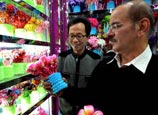
Edited and Translated by Liang Jun, People's Daily Online
When Japan's new prime minister Shinzo Abe took office, he put forward three “arrows” in economic policy to revive Japan’s economy. They are expansion of government spending to stimulate economic growth, implementation of positive monetary policy and regulatory reform-dominated growth strategy. Its core is to control deflation which is an important factor for a long-term downturn. The measures is are so-called Abenomics.
The first two arrows have been shot. Japan invests 10 trillion yen in fiscal year 2013 in infrastructure investment to increase domestic demand and stimulate economic growth. The second is to break the independence of the Bank of Japan and set a 2 percent annual inflation goal directly to it, and to start the machine to print money and manipulate the yen devaluation considerably. The growth strategy of the third arrow will not be revealed until June before the Senate election.
Is Abenomics a magic drug to really save the Japanese economy? In fact, Abe’s first two arrows are nothing new and they have been proved effectively by Japanese government over the past two decades. And the difference is that he uses a higher dose of the drug this time.
First of all, Abe’s stimulus plan uses the largest amount of funds in the history, although it brought temporary prosperity, Japan's debt will further expands.
Secondly, after the Group of Seven's Plaza Accord in the mid-1980s forced appreciation of yen exchange rate, Japan took a round of easy monetary policies to hedge the pains caused by the appreciation of the yen, but it spawned huge asset bubbles. Abe seems to have greater courage this time to initiate infinite quantitative easing and use artificial inflation as an engine to spur economic growth.
 |
















 Snowfall hits Taiyuan, N China
Snowfall hits Taiyuan, N China


![]()
